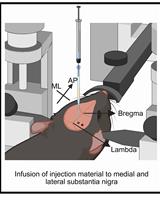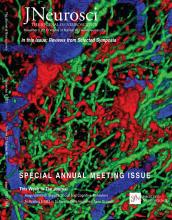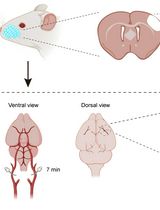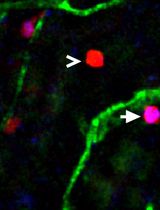- EN - English
- CN - 中文
Induction of Photothrombotic Stroke in the Sensorimotor Cortex of Rats and Preparation of Tissue for Analysis of Stroke Volume and Topographical Cortical Localization of Ischemic Infarct
大鼠感觉运动皮层脑卒中的诱导性光栓疗法及用于卒中体积分析和缺血性梗死地形图皮层定位的组织制备
发布: 2018年05月20日第8卷第10期 DOI: 10.21769/BioProtoc.2861 浏览次数: 12598
评审: Oneil G. BhalalaMiao HePatrick Ovando-Roche

相关实验方案

基于 rAAV-α-Syn 与 α-Syn 预成纤维共同构建的帕金森病一体化小鼠模型
Santhosh Kumar Subramanya [...] Poonam Thakur
2025年12月05日 1406 阅读
Abstract
The photothrombotic model of stroke is commonly used in research as it allows the ischemic infarct to be targeted to specific regions of the cortex with high reproducibility and well-defined infarct borders. Unlike other models of stroke, photothrombosis allows the precise size and location of infarct to be tightly controlled with minimal surgical invasion. Photothrombosis is induced when a circulating photosensitive dye is irradiated in vivo, resulting in focal disruption of the endothelium, activation of platelets and occlusion of the microvasculature (Watson et al., 1985; Dietrich et al., 1987; Carmichael, 2005). The protocols here define how photothrombosis can be specifically targeted to the sensorimotor forelimb cortex of rat with high reproducibility. Detailed methods on rat cortical tissue processing to allow for accurate analysis of stroke volume and stereotactic determination of the precise cortical region of ischemic damage are provided.
Keywords: Photothrombosis (光栓疗法)Background
The photothrombotic model of stroke allows for the precise placement of an ischemic infarct in specific regions of the cortex (Carmichael, 2005; Underly and Shih, 2017). Photothrombosis can be used to occlude specific arteries and arterial branches in the cortex (Carmichael et al., 2005), individual vessels of the pia (Taylor and Shih, 2013) and defined cortical areas such as the barrel field (Dietrich et al., 1987) and hind limb somatosensory cortex (Que et al., 1999). Using this approach, highly reproducible ischemic infarcts have been generated in many experimental animal models including rodents (Watson et al., 1985; Carmichael et al., 2005) and non-human primates (Ikeda et al., 2013). Photothrombosis of the forelimb sensorimotor cortex is useful as it results in localized sensorimotor impairment in forelimb use that can be carefully quantified using a variety of behavioral tests after stroke and during recovery (Sist et al., 2014; Wiersma et al., 2017). The methods presented here allows for the induction of consistent ischemic infarcts of the forelimb sensorimotor cortex that result in significant and long-lasting deficits in forelimb motor function (Wiersma et al., 2017). There is currently no standardized method of identifying both the volume of induced stroke and the anatomical location of stroke in the cortex. Here, we provide methods on systematic identification of the precise cortical location of photothrombotic infarct and analysis of stroke volume. Exclusion criteria for animal stroke models are widely varied. Therefore we provide guidelines to establish criteria for exclusion of animals that deviate from expected stroke volumes or stereotaxic locations.
Materials and Reagents
- Surgical
- Sterile scalpel blade # 10 (Fine Scientific Tools, catalog number: 10100-00 )
- Blunt 16-gauge needle (STEMCELL Technologies, catalog number: 28110 )
- 1 ml syringes x 5 (BD, catalog number: 309659 )
- I.V. catheter 24G x 5/8” (Smiths Medical, Jelco®, catalog number: 4073 )
- Silk suture 5-0, P-3 reverse cutting (Ethicon, PERMAHAND®, catalog number: 640G )
- Sprague-Dawley rat, male, ~500 g, 15-20 weeks of age (Charles River)
- Isoflurane USP 99% (Fresenius Kabi, catalog number: CP0406V2 )
- Compressed oxygen gas with high purity 99.995% (Praxair)
- Compressed nitrous oxide gas 99% purity (Praxair)
- BetadineTM surgical scrub (Fisher Scientific, catalog number: 19-027132)
Manufacturer: Purdue Pharma, catalog number: 6761815117 . - Sterile saline, 0.9% NaCl (Baxter, catalog number: 2B1324X )
- Rose bengal (Sigma-Aldrich, catalog number: 330000 )
- 0.25% Bupivacaine (Sigma-Aldrich, catalog number: B5274 )
- Buprenorphine (Schering- Plough, 0.2 mg injectable)
- Rose bengal solution (see Recipes)
- Sterile scalpel blade # 10 (Fine Scientific Tools, catalog number: 10100-00 )
- Perfusion
- Euthasol® (VIRBAC, catalog number: 710101 )
- Celline isotonic saline solution (Fisher Scientific, catalog number: 351142-10)
Manufacturer: SCP SCIENTIFIC, catalog number: CS20310D . - Heparin (Sigma-Aldrich, catalog number: H3393 )
- Formalin 1:10 dilution, buffered (Fisher Scientific, catalog number: SF100-20 )
- Isotonic saline heparin (5,000 IU/L) solution (see Recipes)
- 4% formalin solution (see Recipes)
- Euthasol® (VIRBAC, catalog number: 710101 )
- Tissue Cryosectioning
- Superfrost® plus gold slides (Fisher Scientific, catalog number: 22-035813 )
- 2-methylbutane (Sigma-Aldrich, catalog number: 277258 )
- D-Sucrose (Fisher Scientific, catalog number: 10638403 )
- Tissue Tek® OCT compound (Sakura, catalog number: 4583 )
- 30% sucrose solution (see Recipes)
- Superfrost® plus gold slides (Fisher Scientific, catalog number: 22-035813 )
- Stroke Analysis
- Rat atlas (Paxinos, George, and Charles Watson. The rat brain in stereotaxic coordinates: hard cover edition. Access Online via Elsevier, 2006. A tool by Matt Gaidica.)
- Rat atlas (Paxinos, George, and Charles Watson. The rat brain in stereotaxic coordinates: hard cover edition. Access Online via Elsevier, 2006. A tool by Matt Gaidica.)
Equipment
- Heating pad with rectal thermometer (Stoelting, catalog number: 50300 )
- Sterile Crile hemostat (Fine Science Tools, catalog number: 13004-14 )
- Sterile blunt ended scissors (Fine Science Tools, catalog number: 14001-18 )
- Sterile rongeur (Fine Science Tools, catalog number: 16000-14 )
- Carbide burs drill bit (SS WHITE, catalog number: 14002-5 )
- Perfusion tray (Thermo Fisher Scientific, Thermo ScientificTM, catalog number: 11469 )
- Sterile scoop (Fine Science Tools, catalog number: 10090-13 )
- Weigh scale (Kent Scientific, catalog number: SCL-1015 )
- Electric razor, Mini cordless trimmer (Braintree Scientific, catalog number: CLP-9868 )
- Animal anesthetic system (Harvard Apparatus, catalog number: 72-6467 )
- Anesthetic induction chamber (Smiths Medical, catalog number: V711801 )
- Stereotaxic frame (KOPF INSTRUMENTS, model: Model 963 Standard Accessories)
- Surgical drill–TCM Endo III (Nouvag, catalog number: 31817 )
- Laser 532 nm (Laserglow Technologies, model: LCS-0532 , Power Supply, Laserglow Technologies, model: C5310051X , with Thorlabs dielectric mirror to focus laser, Thorlabs, catalog number: CM1-E02 )
- Laser safety goggles (Laserglow Technologies, catalog number: AGF5565XX )
- Digital Peri-Star Peristaltic Pump (World Precision Instruments, catalog number: PERIPRO-4HS )
- Cryostat (Leica, model: CM3050 S Research Cryostat)
- Leica HCX PL APO L 10x 1.0NA water emersion objective lens
- Leica SP5 Confocal microscope (Leica, model: Leica SP5 )
- Animal surgery stereo microscope (Leica, M-series)
- Inverted microscope (Leica, model: Leica DMI6000B )
Software
- Leica LAS AF Software
- ImageJ
- Prism by Graph Pad vs9
Procedure
文章信息
版权信息
© 2018 The Authors; exclusive licensee Bio-protocol LLC.
如何引用
Readers should cite both the Bio-protocol article and the original research article where this protocol was used:
- Wiersma, A. M. and Winship, I. R. (2018). Induction of Photothrombotic Stroke in the Sensorimotor Cortex of Rats and Preparation of Tissue for Analysis of Stroke Volume and Topographical Cortical Localization of Ischemic Infarct. Bio-protocol 8(10): e2861. DOI: 10.21769/BioProtoc.2861.
- Wiersma, A. M., Fouad, K. and Winship, I. R. (2017). Enhancing spinal plasticity amplifies the benefits of rehabilitative training and improves recovery from stroke. J Neurosci 37(45): 10983-10997.
分类
神经科学 > 神经系统疾病 > 动物模型
神经科学 > 神经系统疾病 > 脑卒中
细胞生物学 > 组织分析 > 损伤模型
您对这篇实验方法有问题吗?
在此处发布您的问题,我们将邀请本文作者来回答。同时,我们会将您的问题发布到Bio-protocol Exchange,以便寻求社区成员的帮助。
Share
Bluesky
X
Copy link


.jpg)








